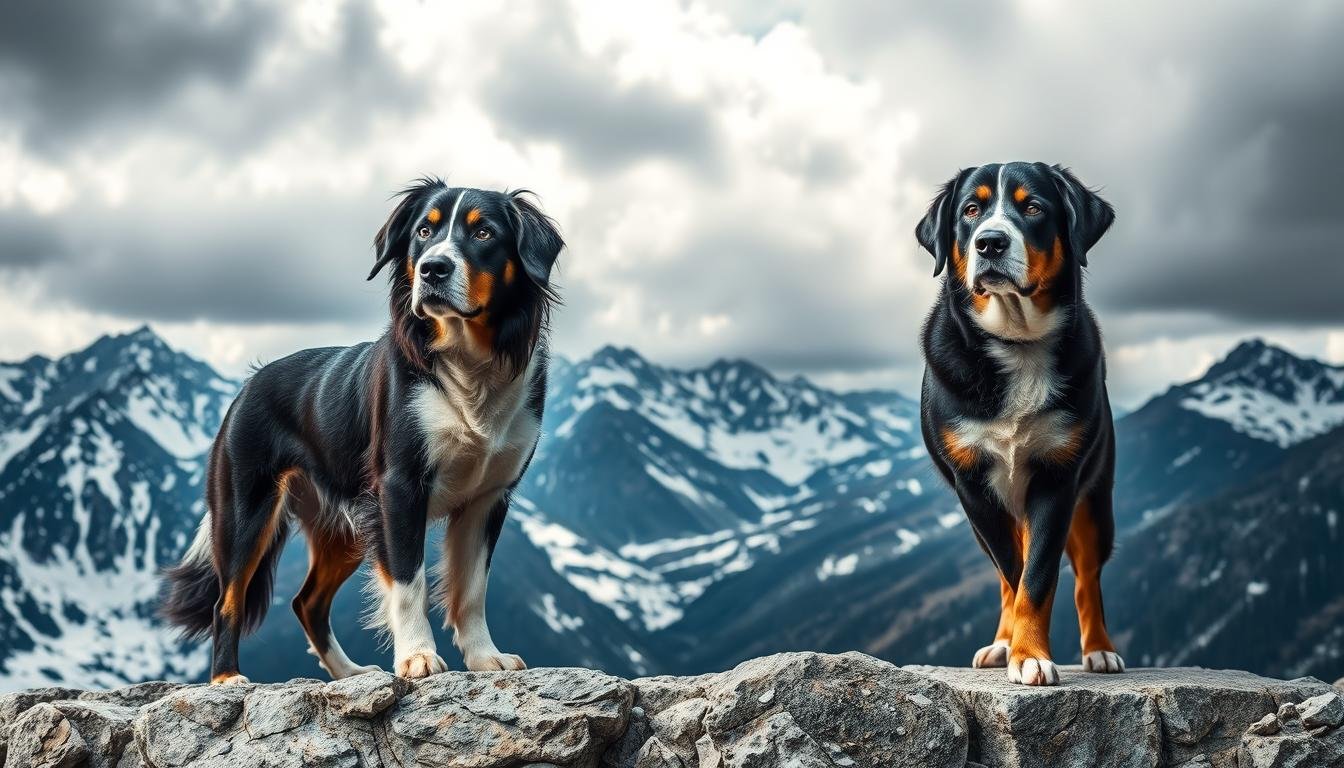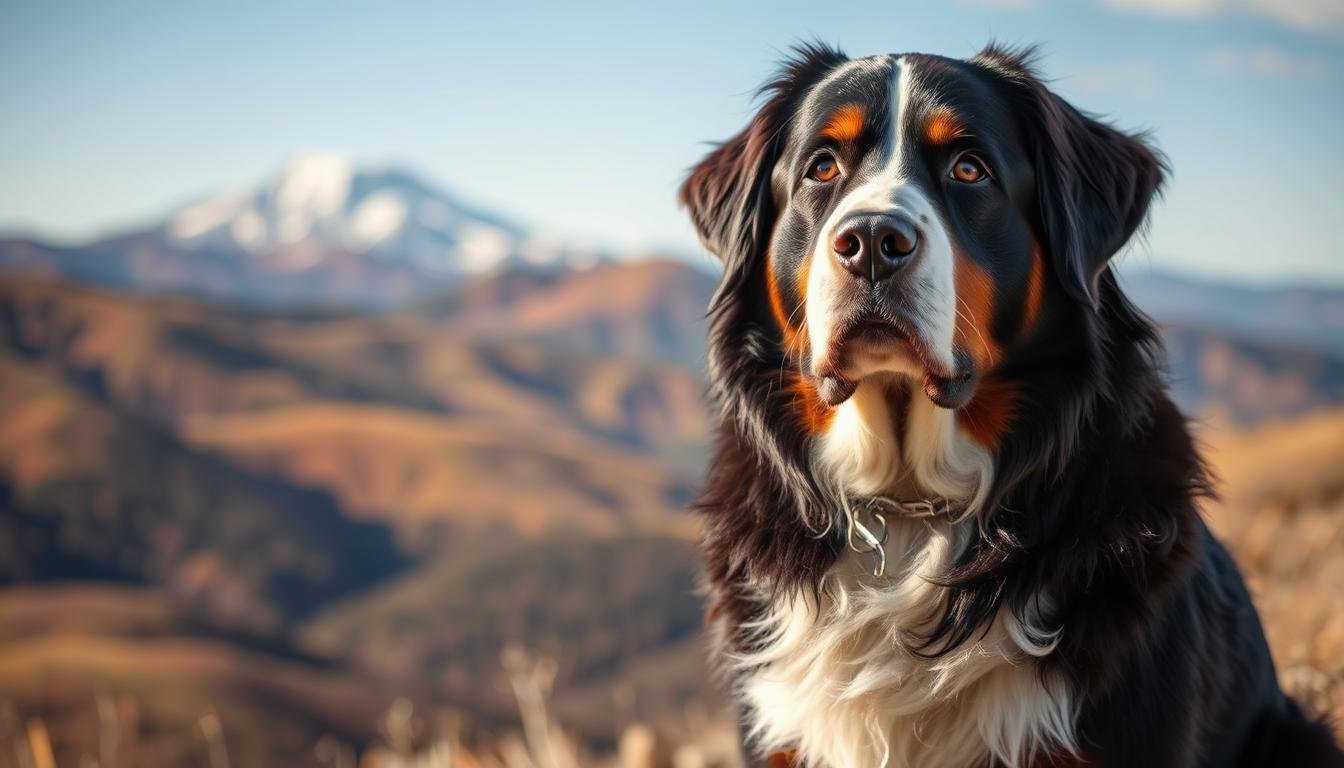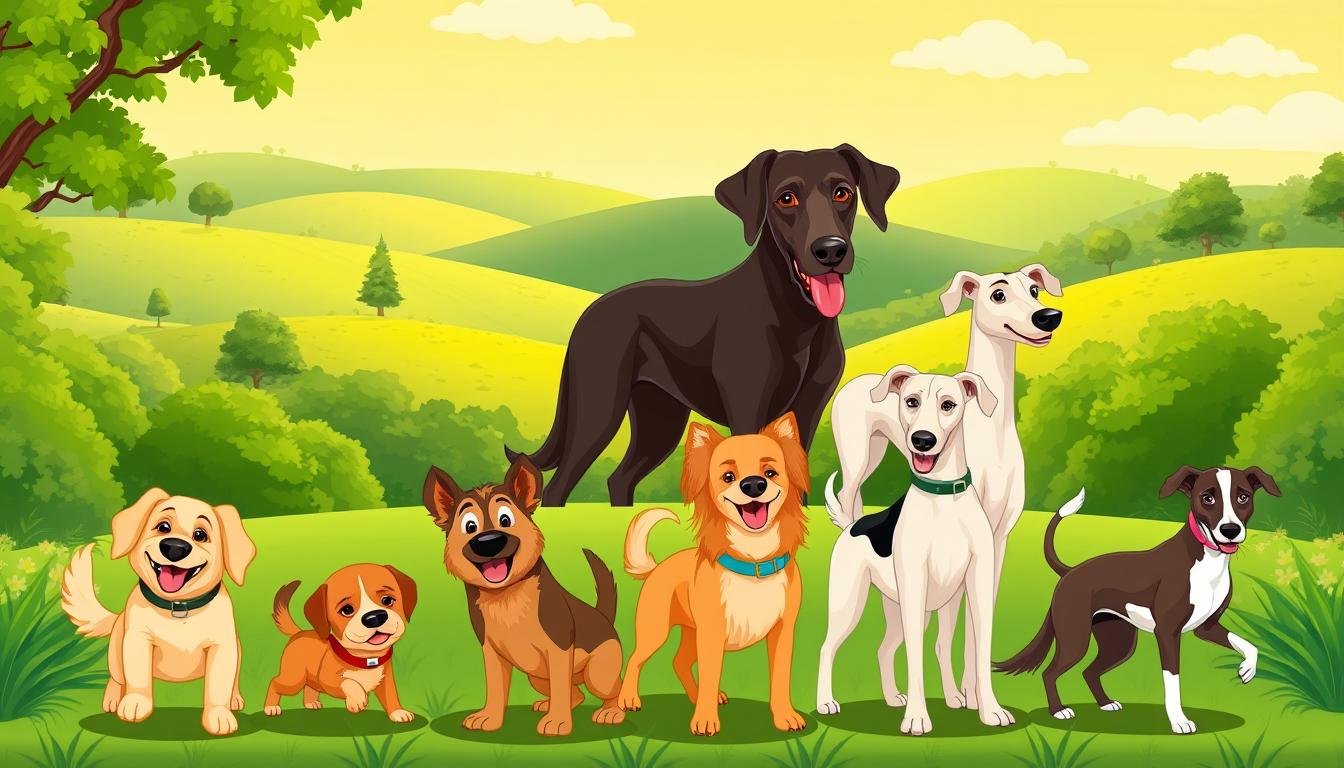Ever found yourself scrolling through adorable puppy photos at midnight, torn between two stunning tri-colored breeds? We’ve been there too. These majestic canines from the Swiss Alps share more than just picturesque backgrounds – they carry centuries of working heritage in every wag.
While both flaunt that signature ”I belong on a postcard” look, their personalities couldn’t be more distinct. One’s the life-of-the-party socialite, the other your thoughtful homebody. Their care requirements? Let’s just say one might have you buying stock in vacuum cleaner companies.
We’re slicing through the confusion like a hiker through fresh powder. From exercise needs that could rival a CrossFit coach’s regimen to health considerations that’ll make you want to hug your vet, we’ve mapped every crucial detail. By the end, you’ll know whether your future involves marathon training sessions or cozy couch cuddles.
Key Takeaways
- Both breeds thrive on human connection but express loyalty differently
- Exercise needs vary dramatically – one requires space to roam, the other prefers structured activities
- Grooming routines impact weekly time commitments
- Health profiles differ significantly between the two
- Temperament ranges from outgoing to reserved
- Lifespan variations should influence long-term planning
Introduction to These Majestic Alpine Breeds
Picture four-legged professionals clocking into work before sunrise – that’s the legacy of these iconic tri-coated helpers. The Sennenhunde crew (pronounced “zen-en-hoon-deh”) didn’t just survive harsh Alpine conditions; they thrived as essential partners to Swiss dairy farmers.
Overview of the Breeds
This elite group includes four distinct members, each with specialized skills. The Greater Swiss Mountain Dog served as the original heavy hauler, while the Bernese Mountain Dog became the all-purpose farmhand. Two smaller cousins complete the set – the vigilant Appenzeller and compact Entlebucher.
| Breed | Primary Role | Distinct Trait |
|---|---|---|
| Greater Swiss | Cart pulling | Powerhouse build |
| Bernese | Multi-tasker | Longer coat |
| Appenzeller | Herding | High energy |
| Entlebucher | Drovers | Compact size |
Understanding Their Roles and History
These breeds didn’t just assist farmers – they ran the operations. From moving 1,000-pound milk carts to tracking stray livestock across cliffs, their work ethic puts most productivity apps to shame. The “Senn” herders relied on them like modern workers depend on smartphones – except these furry helpers never needed charging.
Their signature black-white-rust coats weren’t fashion statements. The patterns helped farmers spot dogs against snowy landscapes – a practical feature that became their trademark. Today’s versions might not haul cheese wheels, but that determined glint in their eyes? That’s 100% authentic heritage.
Breed Origins, History, and Working Heritage
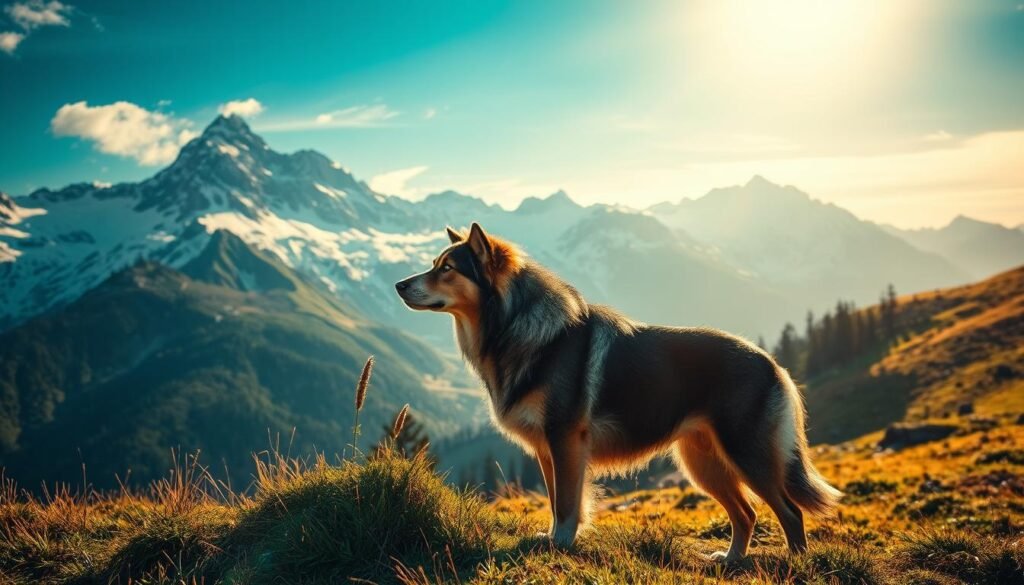
Let’s set the scene: armored soldiers crunching through Alpine snow with furry lieutenants hauling siege equipment. This isn’t a fantasy novel – it’s how our four-legged heroes entered history. Two millennia ago, Roman legions brought mastiff-type ancestors of these greater swiss mountain workers to conquer new territories.
Historical Background and Alpine Roots
These dogs bred for battlefield logistics became Switzerland’s ultimate multitool. Imagine a 150-pound canine dragging artillery carts up slopes while herding cattle between battles. As one historian notes:
“They carried the weight of Alpine commerce on their backs – literally.”
The bernese mountain dog took a delicious career turn post-Rome. By the Middle Ages, they’d become cheese chauffeurs, transporting dairy through passes where wheels outnumbered wheels on wagons. Their signature tri-color coats? Originally dirt camouflage for hardworking pups.
Evolution from Farm Dogs to Companions
America discovered these Alpine marvels in waves. The bernese mountain pair Felix and Fridy arrived in 1936 like furry ambassadors, while their greater swiss mountain cousins needed extra convincing – they didn’t debut stateside until 1968.
| Breed | Origin Story | American Debut |
|---|---|---|
| Greater Swiss | Roman war dogs | 1968 |
| Bernese | Medieval dairy runners | 1936 |
Modern versions still have that “I’ll save you from a snowbank” energy, though now they channel it into carrying groceries instead of cannons. AKC recognition formalized their status, but let’s be real – these breed legends were always championship material.
Physical Appearance and Coat Comparison
You’ll spot the difference before they even wag. These Alpine athletes wear their job descriptions in their silhouettes – one built like a draft horse, the other sporting enough fur to make a sheep jealous.
Size, Build, and Proportions
The Greater Swiss redefines “big boned.” Males stand at 28.5 inches tall – think Great Dane height with linebacker shoulders. Their 115-140 lb frame means they’ll accidentally redecorate your living room with a single tail wag.
Bernese Mountain Dogs play the “compact” card at 27.5 inches and 80-115 lbs. It’s like comparing two SUVs – one’s a heavy-duty pickup, the other an all-wheel-drive family wagon. Both will still dominate your bed space.
Coat Characteristics and Grooming Needs
Bernese coats flow like Alpine streams – long, glossy, and high-maintenance. Their thick undercoat requires weekly brushing marathons. The Greater Swiss sports a practical ‘do: dense fur with shorter outer hairs that say “I hike mountains before breakfast.”
| Breed | Coat Length | Grooming Frequency |
|---|---|---|
| Bernese | Long | Daily brushing |
| Greater Swiss | Short/Medium | 3x weekly |
Both breeds come with built-in snow gear – that thick undercoat sheds like it’s going out of style. Spring brings enough fur to knit sweaters for the whole neighborhood. Regular grooming isn’t optional unless you enjoy wearing dog hair as accessories.
Distinctive Traits: swiss mountain dog vs bernese mountain dog
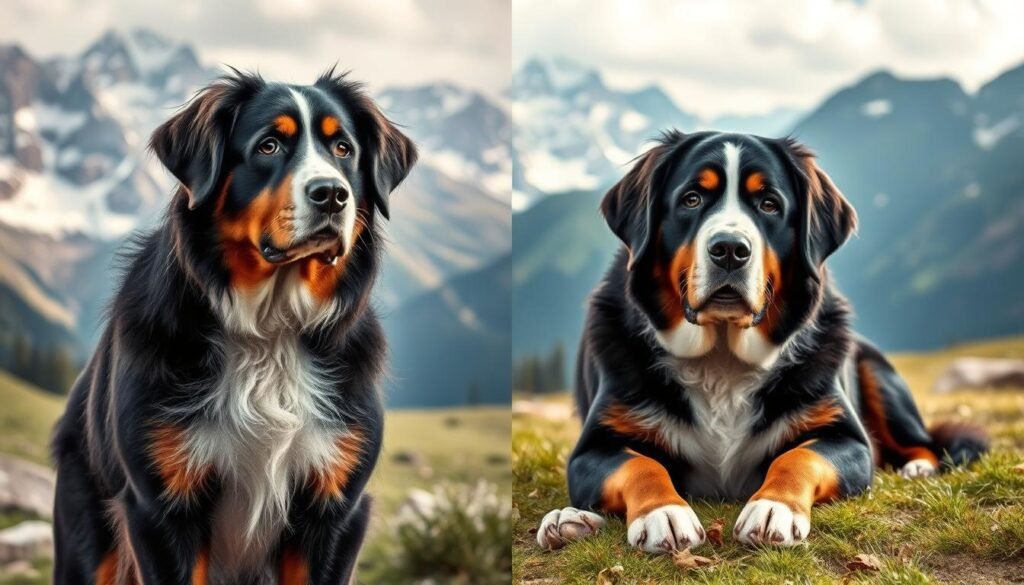
Imagine living with a furry diplomat versus a four-legged debate champion. That’s the daily reality when comparing these Alpine breeds’ personalities. Their approaches to life reveal why some owners become die-hard fans of one breed over the other.
Temperament and Trainability
The Bernese Mountain Dog walks into training sessions like an overachieving student. They’ll sit before you ask and stay until you blink. Their eager-to-please nature makes them ideal for first-time owners. Positive reinforcement works like magic – one “good boy” and they’re hooked.
Their Swiss cousins? Think of a philosophy professor who questions every command. The Greater Swiss needs convincing that your ideas beat their instincts. Treats become bargaining chips, and patience turns into your superpower. They’re not stubborn – just selectively cooperative.
Unique Behavioral and Working Traits
Berners express love through gentle leans and watchful eyes. They’ll shadow your movements like living security blankets. Swissies show devotion by turning fetch into an Olympic trial. Their energy lasts longer than a toddler’s birthday party.
| Trait | Bernese | Greater Swiss |
|---|---|---|
| Focus During Training | Laser-guided | Squirrel-inspired |
| Affection Style | Quiet companion | Full-body wagging |
| Energy Peak | Morning bursts | All-day endurance |
Both breeds bond deeply with families, but their loyalty plays out differently. The Bernese becomes your personal assistant, while the Swiss transforms into an enthusiastic adventure partner. Choose based on whether you want a serene shadow or a living alarm clock.
Exercise Requirements and Outdoor Adventure Needs
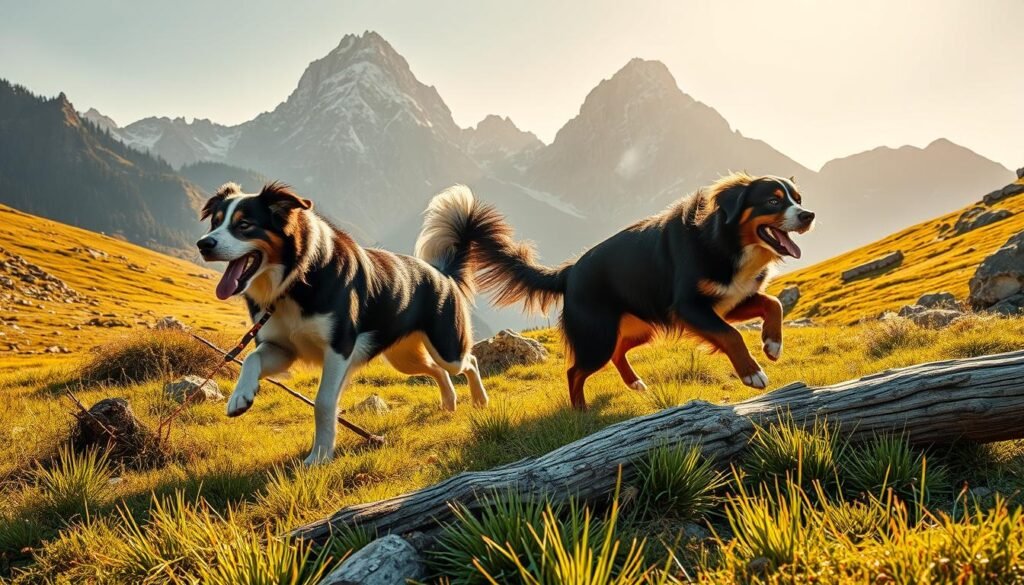
Think of these Alpine athletes as your personal trainers – one’s the drill sergeant, the other your encouraging jogging partner. Their workout styles mirror their personalities: relentless endurance meets joyful exploration.
Daily Activity and Endurance
Both breeds demand 60+ minutes of heart-pumping action daily. The Swiss Mountain Dog treats exercise like a triathlon qualifier – think agility courses or weight-pulling challenges. Their ancestors didn’t drag Roman chariots for show.
The Bernese Mountain crew prefers scenic hikes with snack breaks. They’ll happily plunge into lakes or play tug-of-war until your arms ache. As one owner joked: “Mine considers carrying groceries upstairs his Ironman event.”
| Activity | Swiss Mountain | Bernese Mountain |
|---|---|---|
| Intensity | High-impact | Moderate |
| Endurance | Marathon-ready | Sprint-focused |
| Weather Tolerance | Blizzards welcome | Prefers cooler temps |
These working dogs thrive on purpose-driven tasks. Forget basic fetch – try cart-pulling drills or scent games. Their “why walk when you can work?” mentality makes standard leashed strolls about as exciting as watching paint dry.
Pro tip: Always consult breeders about joint-friendly exercises. Those sturdy frames need smart conditioning, not just brute-force workouts. Whether you’re training for mountain treks or backyard Olympics, these pups will keep you honest – and exhausted.
Health Considerations and Common Issues
Behind those soulful eyes lie some genetic surprises you’ll want to prep for. These sturdy companions may look invincible, but their impressive size comes with specific vulnerabilities. Let’s unpack what keeps owners and vets on high alert.
Genetic Conditions and Joint Health
Both breeds hit the genetic lottery for joint issues – and not the good kind. Hip and elbow dysplasia top the charts, turning stairs into potential obstacle courses. Regular check-ups become non-negotiable, especially when they’re growing faster than your favorite houseplant.
The Greater Swiss Mountain Dog health profile (detailed in this comprehensive guide) shows higher rates of bloat risks. Bernese Mountain Dogs face shorter average lifespans, often due to cancer risks. We recommend orthopedic beds and joint supplements before they even think about limping.
Managing Heatstroke and Other Concerns
That luxurious coat? It’s thermal underwear in July. These cold-weather champs overheat faster than smartphones in direct sunlight. We’ve seen creative solutions – frozen treat puzzles, kiddie pools, and 6 AM walks before the pavement sizzles.
Other red flags include eyelid abnormalities and urinary incontinence in older females. Pro tip: Train them to drink slowly. Gulping water leads to bloat faster than you can say “emergency vet visit.” Stay vigilant, and you’ll keep those tails wagging through all four seasons.

